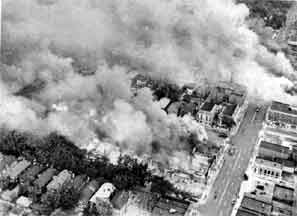1964 Rioting in US Cities

|
The summer of 1964 was marked by significant racial disturbances in major American cities, reflecting deep-seated tensions and widespread dissatisfaction with the slow progress of civil rights reforms. One of the most notable incidents occurred in Harlem, New York City, setting off a wave of unrest that would spread to other cities across the nation.
The Harlem riot began on July 16, 1964, after an altercation between a white off-duty police officer, Thomas Gilligan, and a Black teenager, James Powell. The incident started when Powell and some friends were chased out of a building by a building superintendent who had doused them with water. Officer Gilligan, who was nearby, confronted the group, and in the ensuing scuffle, he shot and killed 15-year-old Powell. The shooting sparked immediate outrage among the Black community in Harlem, who saw it as yet another example of the pervasive police brutality and racial injustice they faced daily.
News of Powell's death spread quickly through the community, leading to spontaneous protests. Anger and frustration boiled over as demonstrators clashed with police, looted stores, and vandalized property. The situation escalated over the next several days, despite efforts by community leaders to restore calm. The New York Police Department responded with a heavy-handed approach, further inflaming tensions and leading to more violent confrontations. By the time the disturbances subsided, one person had been killed, over 100 people were injured, and hundreds more were arrested.
The unrest in Harlem was a catalyst for similar disturbances in other cities. In Rochester, New York, just days after the Harlem riot, racial tensions erupted following the arrest of a Black man at a block party. The incident quickly escalated into three days of rioting, during which businesses were looted, cars were set on fire, and the National Guard was called in to restore order. The Rochester riot resulted in four deaths, hundreds of injuries, and significant property damage.
Other cities, including Jersey City, Philadelphia, and Chicago, also experienced racial disturbances during the summer of 1964. In each case, the immediate triggers varied, but the underlying causes were strikingly similar: systemic racism, economic inequality, and pervasive police brutality. These conditions had created a volatile environment in which even minor incidents could ignite widespread unrest.
In Jersey City, for example, tensions had been simmering due to discriminatory housing practices and lack of job opportunities for Black residents. The spark came when a white police officer arrested a Black woman for a minor traffic violation. The arrest led to protests, which quickly turned violent as demonstrators clashed with police and vandalized property. Similar patterns of unrest were seen in other cities, where longstanding grievances about racial injustice and economic disparities fueled the fires of discontent.
The federal government's response to the riots was mixed. While President Lyndon B. Johnson expressed sympathy for the frustrations of Black Americans and emphasized the need for continued progress on civil rights, his administration also supported aggressive law enforcement measures to quell the disturbances. Johnson's dual approach reflected the broader tension within the country, as the push for civil rights was met with both support and resistance.
The summer of 1964's racial disturbances highlighted the urgent need for comprehensive social and economic reforms. The Civil Rights Act of 1964, signed into law by President Johnson on July 2, was a significant step forward in the fight against racial discrimination. However, the riots underscored that legal changes alone were insufficient to address the deep-rooted inequalities and systemic racism that plagued American society.
In the aftermath of the riots, many community leaders and activists called for more substantial investments in education, housing, and job opportunities for Black Americans. They argued that addressing the socio-economic disparities at the heart of the unrest was essential for achieving lasting peace and equality.
 >
>